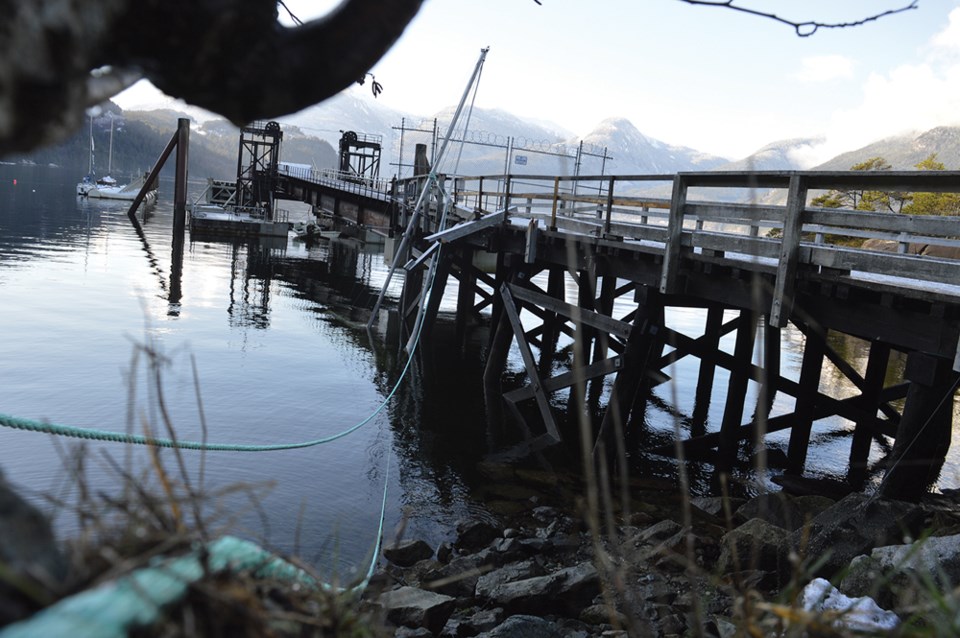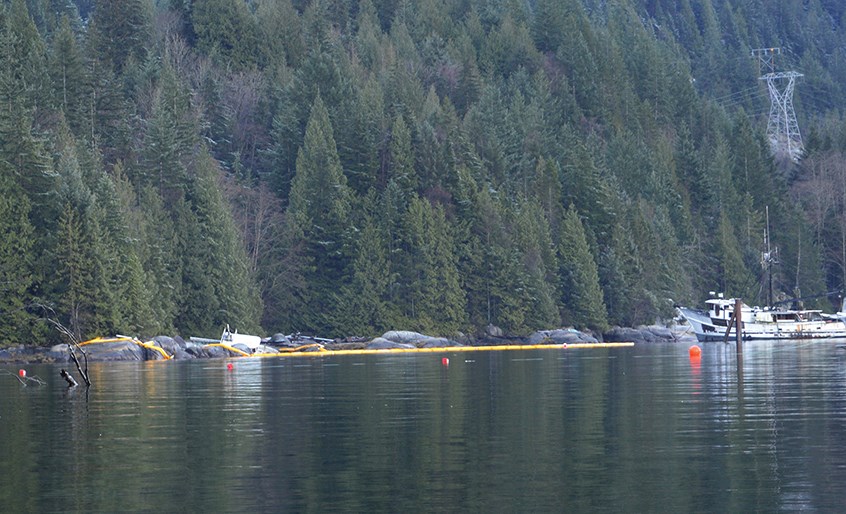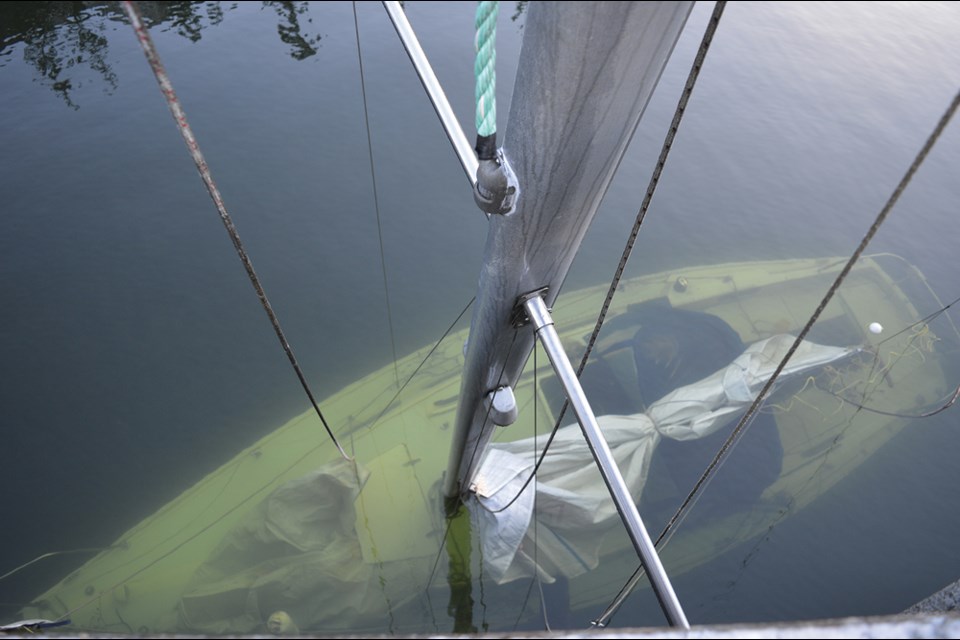Aging boats that sank during the Dec. 20 windstorm are still below the water at Darrell Bay, according to a local conservationist.
John Buchanan says the J.S. Polhemus is still underwater. The 79-foot vessel sank about 100 feet to the bottom of Howe Sound after being battered by 111-kilometre-per-hour winds last month.
Shortly after the storm, the Coast Guard said this boat was leaking fuel.
Aircrews spotted an oily sheen on the water.
A containment boom was then set up in an effort to prevent the spread of hydrocarbons — a compound commonly found in gas and fuel.

A sailboat that plunged about 20 feet underwater still remains submerged right beside the Darrell Bay ferry terminal. It’s been tied to a nearby tree.
Buchanan says the Zena, a former fishing boat, appears to be in dire condition. The vessel was partially submerged after the storm cast it onto the rocks. At least 10 feet of the vessel’s bow is split open, with miscellaneous items strewn along the boat, he says.
A strong fuel smell was still in the air as of Jan. 6, Buchanan told The Chief. He noted that the port side fuel tank appears to be three-quarters full.
Another boat, La Rata Bastarda, has been tied up with a single rope and rests on the seafloor at low tide, says Buchanan. He expressed concern that another big storm could set the vessel adrift.
Finally, a vessel known as the Sea Angel II is afloat in the area as well. There were no reports of this pleasurecraft incurring damage during the windstorm, but it has lately drawn the attention of authorities.
On Jan. 8, Coast Guard officials said that they would be doing assessments of the sunken or possibly damaged boats.
Jeff Brady, the deputy superintendent for environmental response, said that commercial divers would be going down to take a look at the wreck of the Polhemus.
“The objective is to assess the wreck of the J.S. Polhemus for the feasibility of salvage or removal,” said Brady.
“The next objective is to take measures to mitigate any future pollution damages from the vessel J.S. Polhemus.”
Divers may start removing pollutants or patching up any leaks, if possible.
He said crews would also be examining the other boats in the area — the La Rata Bastarda, the Sea Angel II, and the Zena. They’ll be looking to see if these vessels are in danger of leaking pollutants.
“We have a contractor doing a... survey of those other three vessels,” Brady said.
Brady said the Marine Liability Act makes boat owners liable for the costs incurred by the Coast Guard, as well as any bills involving cleaning up pollution damages and prevention measures.
“If it’s determined that there is cost, then the owner will be liable,” he added.
“If the owner doesn’t pay, then we go to the Ship-source Oil Pollution Fund.”
The fund is administered by the federal government in cases where vessels cause oil pollution.
The province will also be on hand to examine the potential impacts of the vessels.
“From a provincial standpoint, we’re just here to assess any pollution impacts to human health and public safety, and to protect any provincial resources or assets, as well,” said Rhonda Brett, emergency response officer with the Ministry of Environment.
It’s still unclear as to when the damaged or sunken vessels will be removed from the area.

However, there is a possible way in which local government may be able to seize ownership and remove abandoned boats. Under a federal initiative called the Abandoned Boats Program, local governments can claim ownership of abandoned vessels and then apply to Ottawa for funding to remove the boats.
But, legal notices must be posted. Owners can then contest whether or not the boat should be considered abandoned.
If the municipality can then successfully classify the vessels as abandoned and then claim them, Transport Canada would then pay up to 75 per cent of the bill for removing the boat.
A spokesperson with The District of Squamish said the municipality is aware of the opportunities through the federal abandoned boats funding program.
“We have not applied for funding to date and defer to the Coast Guard as the lead agency in Darrell Bay, currently,” said Christina Moore in an email.
“We would consider applying for funding in a situation where a boat has been truly abandoned — i.e. if an owner does not respond to a legal notice advising that the boat could be taken possession of and removed. The legal notices are a mandatory step under the federal government’s Abandoned Boats Program.”
Moore said that the District’s focus in the last two years has been to work with partners to clean up the derelict and abandoned vessels in the Mamquam Blind Channel, where she said the situation was critical in terms of environmental concern.
Another law, which is due to come into effect this year may also be of assistance.
Jason van der Valk, a vessels of concern officer with the Coast Guard, said that Bill C-64, or the Wrecked, Abandoned or Hazardous Vessels Act could be of help.
It’s expected to give authorities more power to deal with abandoned derelict vessels.
“They will have [vessels of concern] officers — which is what I am — that will be able to enforce this act,” said van der Valk. “This is the legislation that’s been needed for quite some time.”
Boats would be evaluated by authorities for risk of pollution and danger to humans and animals, among other things.
If the assessed risk is high enough, boats could be removed, van der Valk said.
“This area, it’s been a hotspot on our Coast Guard environmental response team and other partner agencies as well,” he said.
Authorities also asked that the public stay clear as government crews work in the area.
Since the sinkings, much local attention was drawn to Steen Larsen, a Squamish resident whom many believe is responsible for the boats.
Larsen previously told The Chief he owns the sailboat and the La Rata Bastarda.
He also said he is not the owner of the Zena and the Polhemus — rather, he was looking after the boats on behalf of his friends.
It is unclear who owns or has been taking care of the Sea Angel II.
In late December, Larsen said that he’d have the sailboat lifted out before New Year’s, though as of Jan. 8 it’s still underwater.
He also said at the time he’d bring in one of his large vessels from the U.S. to help remove the Zena, though that would take about a month.
The Chief contacted Larsen on Jan. 7, but he said he wouldn’t be able to comment before press time.
He asked The Chief to contact him again on Jan. 8, which the paper did, but this time he said he had to attend to an urgent personal matter.
Updated Jan. 10 with a comment from the District of Squamish.




